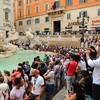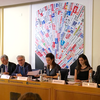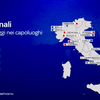Italy, EU Agree on Sea Rescue Mission
This week’s agreement, negotiated in Brussels between Italy’s Interior Minister Angelino Alfano and the EU Commissioner for Internal Affairs Cecilia Malmstroem, calls for Italy’s go-it-alone rescue mission to be replaced within months by a shared EU project to be called “Frontex Plus.” As Malmstroem acknowledged, Italy has `’worked immensely to save thousands of people [but] it is an effort that Italy cannot conduct entirely on its own.” An editorial in La Stampa hailed the beginning of a broader agreement “a little miracle.” Frontex itself already exists but spends as only as much in one year as Italy spends in a single month.
Some critics of Italy’s Mare Nostrum project have maintained that its very existence encourages the clandestine traffickers to hustle ever more immigrants into the Mediterranean, on grounds that they know the Italian government will lend a helping hand. The counter-argument is that the surge in their numbers is due to the traumatic situations in Syria, Eritrea, Somalia, Gaza and Libya itself, which also happens to be the main transit point for those escaping troubles in sub-Sahara Africa. The newer statistics tend to prove the point: whereas only a few years ago the immigrants were primarily men seeking work, today they are entire families from war-torn zones. On August 27, for example, the 449 immigrants who landed at Pozzallo, near Raguso in Sicily, originated in Syria, Gaza and Egypt. Almost half were women and children; they included 81 women (three of whom pregnant, another diabetic) plus 133 children, one of whom was clutching a small white cat. Two of the men taken aboard had been injured.
An Aug. 26 report from BlogSicilia, dateline Ragusa, tells one of their stories. Gibril Jammeh, age 19, of Gambia, was arrested by Ragusa police because considered the trafficker who had arrived in Italy on a damaged rubber boat carrying 97 survivors plus 18 dead bodies. Interviewed by police, he said that each migrant had paid the traffickers $1,200, but that he was not one of them. Having no money to pay for his trip, he told the traffickers that he was a fisherman and could drive the boat. The traffickers agreed, but as people went aboard they suddenly began striking savagely with iron bars at some. Several who appeared to have fainted had in fact died from the beating, Jammeh recounted. En route the rubber boat developed a hole in the prow. As panic set in, a passenger, hoping to use it as a life preserver, emptied a fuel container into the boat, with the result of more panic and the deaths of others during the journey from breathing poisonous fuel fumes mixed with salt water. Two brothers fell into the sea and died (again, from Jammeh’ account). See >>>
In the meantime 100 Palestinians fleeing from Gaza plus 300 other immigrants had been taken aboard a British ship 90 miles South of Crete on August 24. They too were brought to Pozzalla, meaning that altogether in the last week some 1,265 live immigrants plus 18 dead were delivered into the Sicilian port.
What will the new agreement with the EU mean? For the moment, fellow EU countries are yet to be formally asked just how they can and will contribute. Mare Nostrum would continue in a reduced form, but the present plan is for EU ships not to be allowed to go beyond their nation’s territorial miles for rescues; if a craft is sinking beyond the usually accepted 12 territorial miles, other ships in the vicinity would be notified, but EU ships would not take action until inside its waters. Another tentative provision is for the destruction of the traffickers’ boats (amazingly, this is not yet the case although some traffickers have been arrested by Italian police).
In an interview published in the daily La Repubblica Aug. 28, Carlotta Sami, spokesperson for the United Nations High Commission for Refugees for Southern Europe, called the new agreement “positive, but with two reservations: first, we don’t yet have the details for Frontex Plus: the nationality of its ships, who is to take command, to what ports those rescued are to be taken. Secondly, the new structure must be no less equipped [with ships, aircraft, hospitals] than Mare Nostrum.”
Another question under discussion is what action can be taken in now war-torn Libya. Is there a way to bring a halt to the wave of immigration? It may be that the truce in Gaza will help, but there is no lack of wars elsewhere, beginning in Syria. The challenge remains immense—and growing.





































i-Italy
Facebook
Google+
This work may not be reproduced, in whole or in part, without prior written permission.
Questo lavoro non può essere riprodotto, in tutto o in parte, senza permesso scritto.